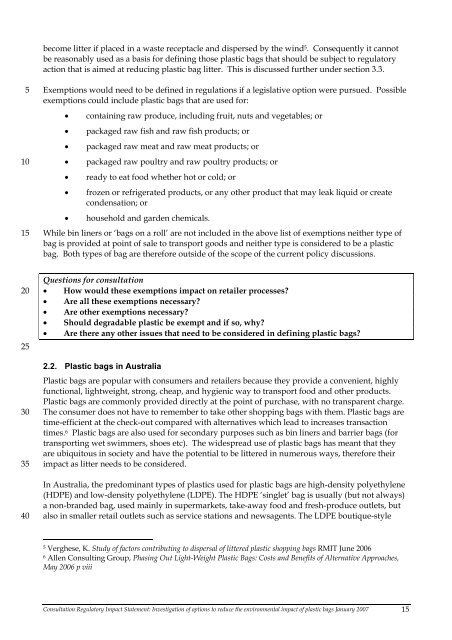Plastic Bags - COAG Standing Council on Environment and Water
Plastic Bags - COAG Standing Council on Environment and Water
Plastic Bags - COAG Standing Council on Environment and Water
You also want an ePaper? Increase the reach of your titles
YUMPU automatically turns print PDFs into web optimized ePapers that Google loves.
ecome litter if placed in a waste receptacle <strong>and</strong> dispersed by the wind 5 . C<strong>on</strong>sequently it cannot<br />
be reas<strong>on</strong>ably used as a basis for defining those plastic bags that should be subject to regulatory<br />
acti<strong>on</strong> that is aimed at reducing plastic bag litter. This is discussed further under secti<strong>on</strong> 3.3.<br />
5<br />
10<br />
15<br />
Exempti<strong>on</strong>s would need to be defined in regulati<strong>on</strong>s if a legislative opti<strong>on</strong> were pursued. Possible<br />
exempti<strong>on</strong>s could include plastic bags that are used for:<br />
• c<strong>on</strong>taining raw produce, including fruit, nuts <strong>and</strong> vegetables; or<br />
• packaged raw fish <strong>and</strong> raw fish products; or<br />
• packaged raw meat <strong>and</strong> raw meat products; or<br />
• packaged raw poultry <strong>and</strong> raw poultry products; or<br />
• ready to eat food whether hot or cold; or<br />
• frozen or refrigerated products, or any other product that may leak liquid or create<br />
c<strong>on</strong>densati<strong>on</strong>; or<br />
• household <strong>and</strong> garden chemicals.<br />
While bin liners or ‘bags <strong>on</strong> a roll’ are not included in the above list of exempti<strong>on</strong>s neither type of<br />
bag is provided at point of sale to transport goods <strong>and</strong> neither type is c<strong>on</strong>sidered to be a plastic<br />
bag. Both types of bag are therefore outside of the scope of the current policy discussi<strong>on</strong>s.<br />
20<br />
25<br />
30<br />
35<br />
40<br />
Questi<strong>on</strong>s for c<strong>on</strong>sultati<strong>on</strong><br />
• How would these exempti<strong>on</strong>s impact <strong>on</strong> retailer processes?<br />
• Are all these exempti<strong>on</strong>s necessary?<br />
• Are other exempti<strong>on</strong>s necessary?<br />
• Should degradable plastic be exempt <strong>and</strong> if so, why?<br />
• Are there any other issues that need to be c<strong>on</strong>sidered in defining plastic bags?<br />
2.2. <str<strong>on</strong>g>Plastic</str<strong>on</strong>g> bags in Australia<br />
<str<strong>on</strong>g>Plastic</str<strong>on</strong>g> bags are popular with c<strong>on</strong>sumers <strong>and</strong> retailers because they provide a c<strong>on</strong>venient, highly<br />
functi<strong>on</strong>al, lightweight, str<strong>on</strong>g, cheap, <strong>and</strong> hygienic way to transport food <strong>and</strong> other products.<br />
<str<strong>on</strong>g>Plastic</str<strong>on</strong>g> bags are comm<strong>on</strong>ly provided directly at the point of purchase, with no transparent charge.<br />
The c<strong>on</strong>sumer does not have to remember to take other shopping bags with them. <str<strong>on</strong>g>Plastic</str<strong>on</strong>g> bags are<br />
time-efficient at the check-out compared with alternatives which lead to increases transacti<strong>on</strong><br />
times. 6 <str<strong>on</strong>g>Plastic</str<strong>on</strong>g> bags are also used for sec<strong>on</strong>dary purposes such as bin liners <strong>and</strong> barrier bags (for<br />
transporting wet swimmers, shoes etc). The widespread use of plastic bags has meant that they<br />
are ubiquitous in society <strong>and</strong> have the potential to be littered in numerous ways, therefore their<br />
impact as litter needs to be c<strong>on</strong>sidered.<br />
In Australia, the predominant types of plastics used for plastic bags are high-density polyethylene<br />
(HDPE) <strong>and</strong> low-density polyethylene (LDPE). The HDPE ‘singlet’ bag is usually (but not always)<br />
a n<strong>on</strong>-br<strong>and</strong>ed bag, used mainly in supermarkets, take-away food <strong>and</strong> fresh-produce outlets, but<br />
also in smaller retail outlets such as service stati<strong>on</strong>s <strong>and</strong> newsagents. The LDPE boutique-style<br />
5 Verghese, K. Study of factors c<strong>on</strong>tributing to dispersal of littered plastic shopping bags RMIT June 2006<br />
6 Allen C<strong>on</strong>sulting Group, Phasing Out Light-Weight <str<strong>on</strong>g>Plastic</str<strong>on</strong>g> <str<strong>on</strong>g>Bags</str<strong>on</strong>g>: Costs <strong>and</strong> Benefits of Alternative Approaches,<br />
May 2006 p viii<br />
C<strong>on</strong>sultati<strong>on</strong> Regulatory Impact Statement: Investigati<strong>on</strong> of opti<strong>on</strong>s to reduce the envir<strong>on</strong>mental impact of plastic bags January 2007 15
















